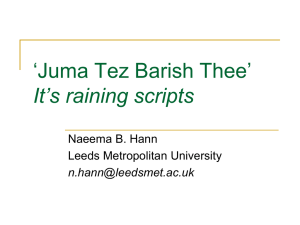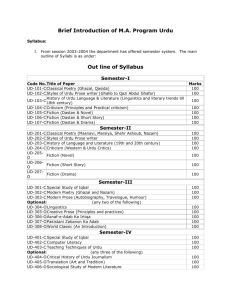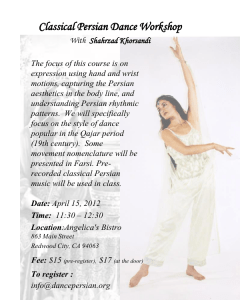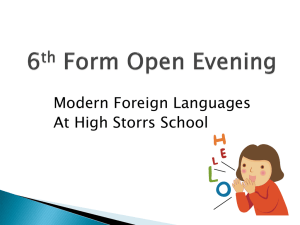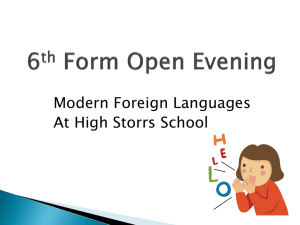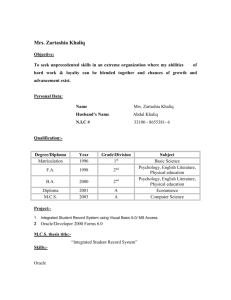Pakistani Language(Urdu)
advertisement
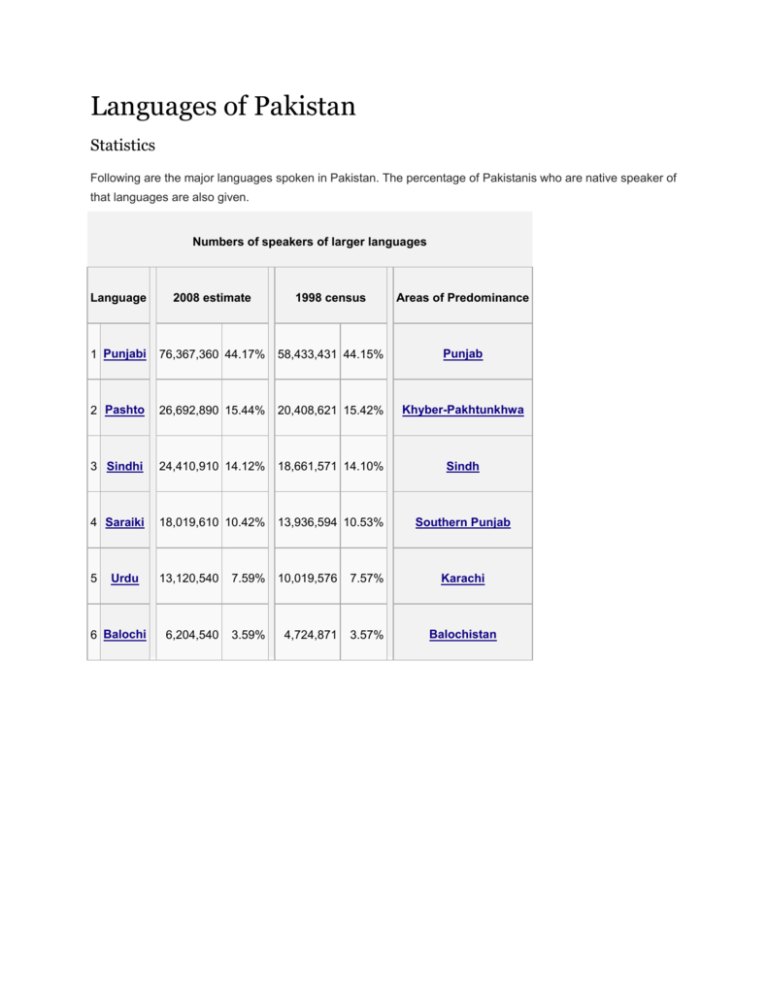
Languages of Pakistan Statistics Following are the major languages spoken in Pakistan. The percentage of Pakistanis who are native speaker of that languages are also given. Numbers of speakers of larger languages Language 2008 estimate 1998 census Areas of Predominance 1 Punjabi 76,367,360 44.17% 58,433,431 44.15% Punjab 2 Pashto 26,692,890 15.44% 20,408,621 15.42% Khyber-Pakhtunkhwa 3 Sindhi 24,410,910 14.12% 18,661,571 14.10% Sindh 4 Saraiki 18,019,610 10.42% 13,936,594 10.53% Southern Punjab 13,120,540 7.59% 10,019,576 7.57% Karachi 6,204,540 3.59% 4,724,871 3.57% Balochistan 5 Urdu 6 Balochi National language: Urdu An example of the Nastaʿlīq script used for writing Urdu Urdu ( )اردوis the national language (ان )ق ومی زب, lingua franca and one of two official languages of Pakistan (the other being English). Although only about 8% of Pakistanis speak it as their first language, it is spoken and understood as a second language by almost all Pakistanis. Its introduction as the lingua francawas encouraged by the British upon the capitulation and annexation of Sindh(1843) and Punjab (1849) with the subsequent ban on the use of Persian. The decision to make the language change was to institute a universal language throughout the then British Raj in South Asia as well as minimize the influence of Persia, the Ottoman Empire, Afghanistan and Central Asia on this transitional region. Urdu is a relatively new language in the contemporary sense but has undergone considerable modifications and development borrowing heavily on the traditions of older languages like Persian, Arabic, Turkish and local South Asian languages all of which can be found in its vocabulary. According to the linguistic historian Tariq Rahman, however, the oldest name of what is now called Urdu is Hindustani or Hindvi and it existed in some form at least from the 14th century if not earlier (Rahman 2011). It was probably the language of the area around Delhi that absorbed words of Persian and Arabic and, to a much lesser extent, Turkish—the same process that created modern English. This language, according to Rahman, is the ancestor of both modern Hindi and Urdu. These became two distinct varieties when Urdu was first Persianized in the 18th century and then Hindi was Sanskritized from 1802 onwards. The name Urdu is a short form of 'Zuban-e-Urdu-e-Mualla' i.e. language of the exalted city. In India the term Urdu, although it means 'military camp' in Turkish, was used for the capital city of the king. In other words, the language of the king's capital was a Persianized form of the language usually called Hindi. This was shortened to 'Urdu' and this term was used for the first time in written records by the poet Mushafi in 1780 (Rahman 2011: 49). The British called this language 'Hindustani' and wrote it in both the Perso-Arabic and the Devanagari script. It is widely used, both formally and informally, for personal letters as well as public literature, in the literary sphere and in the popular media. It is a required subject of study in all primary and secondary schools. It is the first language of most Muhajirs (Muslim refugees who fled from different parts of India after independence of Pakistan in 1947), who form nearly 8% of Pakistan's population, and is an acquired language. As Pakistan's national language, Urdu has been promoted to promote national unity. It is written with a modified form of the Perso-Arabic alphabet—usually in Nastaliq script—and its basic Hindustani vocabulary has been enriched by words from Persian, Arabic,Turkic languages and English. Urdu has drawn inspiration from Persian literature and has now an enormous stock of words from that language. In recent years, the Urdu spoken in Pakistan has gradually been influenced by many of the native languages, such as Pashto,Punjabi and Sindhi, in terms of intonation, as well the incorporation of terminology from those languages. As such, the language is constantly developing and has acquired a particularly "Pakistani" flavour that distinguishes it from the language spoken in ancient times and in India. The first poetry in the ancestor of Urdu-Hindi is attributed to Baba Farid Ganj Shakar of Pakpattan (1175-1265), or the poet Amir Khusro (1253– 1325), but, since the actual writing of the manuscripts is of a later date, this cannot be said with certainty. Lines in what may be understood as Urdu are scattered in the Persian biographies and conversations of saints (Rahman 2011: 61-65) and the first book of Pashto Khairul Bayan, probably written by Bayazid Ansari between 1560 to 1570, has some pages in the Perso-Arabic script that is written in this language. The image of these pages is displayed by Rahman in his book From Hindi to Urdu (2011: 134-135). descendants—while his (or Hindustani) fluently—as did his ancestors mostly spoke Persian and Turkish The Mughal Emperor Aurangzeb Alamgir(1658–1707) spoke Urdu Provincial languages Punjabi Punjabi ( )یباجنپis spoken as a first language by more than 44% of Pakistanis, mostly in Punjab. The exact numbers of Punjabi speakers in Pakistan is difficult to ascertain since there are many dialects, such asSaraiki and Hindko which some regard as part of Punjabi and others regard as a separate language. If both included then 60% population speaks Punjabi which is the exact population proportion of Punjab province to overall country population. The standard Punjabi dialect is from Lahore, Sialkot, Gujranwalaand Sheikhupura districts of the Pakistani Punjab which was used by Waris Shah (1722–1798) in his famous book Heer Ranjha and is also nowadays the language of Punjabi literature and music. Punjabi is descended from Prakrit in the Vedic period (1700 B.C.), Pali, Old Persian and Apabhramsha in the Ashoka period (273 B.C. - 232 B.C.) and Hindvi, Lahori and Multani in the Muslim period (711 A.D. - 1857 A.D.). Punjabi literature was principally spiritual in nature and has had a very rich oral tradition. Pashto Pashto ( )وتښپis spoken as a first language by 15.5% (c. 29 million) of Pakistanis, mainly in Khyber Pakhtunkhwa, Federally Administered Tribal Areas (FATA) and in northern Balochistan as well as in ethnic Pashtun communities in the cities of Karachi, Islamabad, Rawalpindi and Lahore. Karachi is one of the most Pashto speaking cities in the world although Pashto speakers constitute only about 25% of the city's population.[1] Pashto is also widely spoken in neighboring Afghanistan where it has official language status. Pashto has rich written literary traditions as well as an oral tradition. There are two major dialect patterns within which the various individual dialects may be classified; these are Pakhto, which is the Northern (Peshawar) variety, and the softer Pashto spoken in the southern areas. Khushal Khan Khattak (1613–1689) and Rahman Baba (1633–1708) were famous poets in the Pashto language. In the last part of 20th century, Pakhto or Pashto has produced some great poets like Ghani Khan, Khatir Afridi and Amir Hamza Shinwari. They are not included in the overall percentage. Sindhi Sindhi ( )يڌنسis spoken as a first language by 15.5% of Pakistanis, mostly in Sindh, parts of Balochistan, Southern Punjab and Balochistan. It has a rich literature and is taught in schools. It is an Indo-Aryan (IndoEuropean) language, derived fromSanskrit, and Arabic languages. The Arabs ruled Sindh for more than 150 years after Muhammad bin Qasim conquered it in 712 AD, remaining there for three years to set up Arab rule. Consequently, the social fabric of Sindh contains elements of Arabic society. Sindhi is spoken by over 53.4 million people in Pakistan and some 5.8 million in India as well as some 2.6 million in other parts of the world. It is the official language of Sindh province and is one of the scheduled languages officially recognized by the federal government in India. It is widely spoken in the Lasbela District of Balochistan (where the Lasi tribe speaks a dialect of Sindhi), many areas of the Naseerabad, Rahim Yar Khan and Dera Ghazi Khan districts in Sindh andJafarabad districts of Balochistan, and by the Sindhi diaspora abroad. Sindhi language has six major dialects: Sireli, Vicholi, Lari, Thari, Lasi and Kachhi. It is written in the Arabic script with several additional letters to accommodate special sounds. The largest Sindhi-speaking cities are Karachi, Hyderabad, Sukkur, Shikarpur, Dadu, Jacobabad, Larkana and Nawabshah.Sindhi literature is also spiritual in nature. Shah Abdul Latif Bhita'i (1689–1752) is one of its greatest poets, and wrote Sassi Punnun and Umar Marvi, folk stories, in his famous book "Shah Jo Risalo". Balochi Balochi ( )یچولبis spoken as a first language by about 4% of Pakistanis, mostly in Balochistan province. It is believed that the language was brought to its present location in a series of migrations from the Kurdistan region of northeastern Iraq and northwestern Iran. Rakshani is the major dialect group in terms of numbers. Sarhaddi is a sub-dialect of Rakshani. Other sub-dialects are Kalati (Qalati), Chagai-Kharani and Panjguri. Eastern Hill Balochi or Northern Balochi is very different from the rest. Balochi language is very close to the Persian itself. The name Balochi or Baluchi is not found before the 10th Century. It is one of the 9 distinguished languages of Pakistan. Since Balochi is a very poetic and rich language and has a certain degree of affinity to Persian and Urdu, Balochi poets tend to be very good poets in Urdu as well and Ata Shaad, Gul Khan Nasir andNoon Meem Danish are excellent examples of this. Regional languages Kashmiri Kashmiri ( )رُشأكis an ancient Dardic language spoken in Azad Kashmir, Gilgit–Baltistan and Punjab provinces of Pakistan. There are over 100,000 [2] Kashmiri speakers in Pakistan. Brahui Brahui ( )یوھاكبis a Dravidian language of central and east-central Balochistan. The language has been influenced by neighboring Balochi and to a lesser extent by Sindhi and Pashto. 1–1.5% of the Pakistani population has Brahui as their first language. It is one of the nine distinguished[clarification needed] languages of Pakistan.The Brahui people have traditionally been taken as a relict population, suggesting that Dravidian languages were formerly more widespread but were supplanted by the incoming Indo-Aryan languages.[3] However, this idea has fallen out of favor; Brahui appears to have migrated to Balochistan from central India after 1000 CE, as evidenced by the absence of Avestan loanwords. The main Iranian contributor to Brahui vocabulary, Balochi, is a western Iranian language like Kurdish that moved to the area from the west only around 1000 CE.[4] Hindko Hindko ( )وکدنہname is derived from Hindukush mountains" is mainly spoken in this mountain range in the districts of Haripur, Abbottabad, Mansehra, Peshawar, Kohat, Nowshera, Swabi, the lower half of Neelum District and Muzafarabad District of Kashmir by an estimated 2.2 to 4 million people.[citation needed]. It is very similar to northern dialects of Punjabi Shina Shina (( )انیشalso known as Tshina) is a Dardic language spoken by a plurality of people in Gilgit– Baltistan of Pakistan. The valleys in which it is spoken include Astore, Chilas, Dareil, Tangeer, Gilgit, Ghizer, and a few parts of Kohistan. It is also spoken in Gurez, Drass, Kargil, Karkit Badgam and Ladakh valleys of Kashmir. There were 321,000 speakers of Gilgiti Shina in 1981. Current estimate is nearly 600,000 people. Saraiki Saraiki ( )یکیئاكسis spoken in southern Punjab,which comprises Multan, Lodhran, Bahawalpur, Bhakkar, Mianwali, Layyah, Dera Ghazi Khan, Muzaffargarh and Rahim Yar Khan districts. It is also spoken by majority of population of Dera Ismail Khan district in Khyber Pakhtunkhwa ( )اوخنوتښپ كبیخprovince, kachi plain of Balochistan, northern parts of Sindh, and also spoken by few people in the cities of Hyderabad and Karachi. More than 18 million Saraiki live in Pakistan, and nearly 100 thousand Saraiki live in other countries specially India, UAE and Saudi Arab. Other languages English (official language) English is one of the official languages of Pakistan (the other being Urdu) and is widely used in the executive, legislative and judicial branches as well as to some extent in the officer ranks of Pakistan's armed forces. Pakistan's Constitution and laws are written in English. It is also widely used in schools, colleges and universities as a medium of instruction. Amongst the more educated social circles of Pakistan, English is seen as the language of upward mobility and its use is becoming more prevalent in upper social circles often spoken alongside native Pakistani languages. For details of the history of the English language in India and Pakistan see Rahman (2002). Arabic (religious language) Arabic ( )يبكعis the religious language of Muslims. The Quran, Sunnah, Hadith and Muslim theology is taught in Arabic withUrdu translation. The Pakistani diaspora living in the Middle East has further increased the number of people who can speak Arabic in Pakistan. Arabic is taught as a religious language in mosques, schools, colleges, universities and madrassahs. A majority of Pakistan's Muslim population has had some form of formal or informal education in the reading, writing and pronunciation of the Arabic language as part of their religious education. Persian (literary language) Main article: Persian language in South Asia See also: Persian and Urdu Persian ( )یسكافwas the language of Muslims in South Asia before the advent of the British and was the official and cultural language of the Mughal Empire. Persian was officially abolished from the region with the arrival of the British: in Sindh in 1843 and in Punjab in 1849 to minimize the influence of the Mughal Empire. It is still spoken and understood by a few in Pakistan as a literary language. Many Dari (Persian) speaking refugees from Afghanistan have settled in Pakistan permanently. Turkic languages (literary language) Turkic ( )کكتlanguages were used by the ruling Turco-Mongols (or Mughals) and earlier Sultans of India many of whom have settled in Pakistan. There are pockets of Turkic speakers found throughout the country, notably in the valleys in the countries northern regions which lie adjacent to Central Asia, western Pakistani region of Waziristan principally around Kanigoramwhere the Burki tribe dwells and in Pakistan's urban centres of Karachi, Lahore and Islamabad. The autobiography of Mughalemperor Babur, Tuzk Babari was also written in Turkish. After returning from exile in Safavid Persia in 1555, Mughal emperorHumayun further introduced Persian language and culture in the court and government. The Chaghatai language, in which Babur had written his memoirs, disappeared almost entirely from the culture of the courtly elite, and Mughal emperor Akbarcould not speak it. Later in life, Humayun himself is said to have spoken in Persian verse more often than not. Many Turkic speaking refugees, mostly Uzbeks and Turkmens, from Afghanistan have settled in Pakistan permanently. The word Urdu is of Turkic origin, as Urdu was originally called Zaban-e-Ordu-e- Mualla or The language of the exalted city,ordu meaning army' in Turkish but the term is used for 'the King's city' or the capital of the ruler in India (Rahman 2011). Minor languages Other languages spoken by linguistic minorities include the languages listed below, with speakers ranging from a few hundred to tens of thousands. A few are highly endangered languages that may soon have no speakers at all.[6] Writing systems Main articles: Nasta'liq script and Urdu alphabet Chalipa panel, Mir Emad All languages of Pakistan are written in Nastaʿlīq, a modified Perso-Arabic script. The Mughal Empire used Persian as the court language during their rule over South Asia. During this time, Nastaʿlīq came into widespread use in South Asia. The influence remains to this day. In Pakistan, almost everything in Urdu is written in the script, concentrating the greater part of Nastaʿlīq usage in the world. The earliest Sindhi manuscripts written during the Abbasid Era After the Islamic conquest of Persia, Iranians adopted the Perso-Arabic script and the art of Persian calligraphy flourished in Iran alongside other Islamic countries. Apparently, Mir Ali Tabrizi (14th century) developedNastaʿlīq by combining two existing scripts of Nasḫ and Taʿlīq. Hence, it was originally called NasḫTaʿlīq. Another theory holds that the name means "that which abrogated (naskh) Taʿlīq". Taʿlīq script, in Arabic calligraphy, cursive style of lettering developed inIran in the 10th century. It is thought to have been the creation of Ḥasan ibn Ḥusayn ʿAlī of Fars, but, because Khwājah ʿAbd al-Malik Buk made such vast improvements, the invention is often attributed to him. The rounded forms and exaggerated horizontal strokes that characterize the taʿlīq letters were derived primarily from the Riqāʿ script. The ornateness and sloping quality of the written line had roots in the Tawqīʿ script of Ibn Muqlah (died 940). Sindhi adopted a variant of the Persian alphabet as well, in the 19th century. The script is used in Pakistan today. It has a total of 52 letters, augmenting the Persian with digraphs and eighteen new letters (ڄ ڄ ڄ ڄ ڄ ڄ )ڪڄڳڄڱڄڻڄڦڄڃڄڇڄڌڄڏڄڊڄڍڄڙfor sounds particular to Sindhi and other Indo-Aryan languages. Some letters that are distinguished in Arabic or Persian arehomophones in Sindhi. The Urdu alphabet is the right-to-leftalphabet used for the Urdu language. It is a modification of the Persian alphabet, which is itself a derivative of the Arabic alphabet. With 38 letters, the Urdu alphabet is typically written in thecalligraphic Nasta'liq script, whereasArabic is more commonly in the Naskhstyle. Usually, bare transliterations of Urdūinto Roman letters, Roman Urdu, omit many phonemic elements that have no equivalent in English or other languages commonly written in the Latin script.[citation needed] The National Language Authority of Pakistan has developed a number of systems with specific notations to signify nonEnglish sounds, but these can only be properly read by someone already familiar with Urdū, Persian language|Persian or Arabic language|Arabic for letters such as ژ خ غ ط صor قand Hindi for letters such as ڑ.[citation needed] Balochi and Pashto are written in Perso-Arabic script. The Shahmukhī script is a local variant of the Urdu alphabet, a modified Persian alphabet, which has been used by thePunjabi Muslims of Punjab to write Punjabi language Urdu Alphabet Learning the Urdu alphabet is very important because its structure is used in every day conversation. Without it, you will not be able to say words properly even if you know how to write those words. The better you pronounce a letter in a word, the more understood you will be in speaking the Urdu language. Below is a table showing the Urdu alphabet and how it is pronounced in English, and finally examples of how those letters would sound if you place them in a word. Urdu Alphabet English Sound Pronunciation Example ا a as in apple ب b as in book پ p as in pool ت t as in time ٹ ṭ as in Togo ث th 'th' as in think ج j as in joy چ ch as in charm ح h as in hot خ kh as in Buch د d as in dove ڈ ḍ as in drink Urdu Alphabet English Sound Pronunciation Example ذ dh 'th' as in that ر r as in rice ڑ ṛ as in rabbit ز z as in zoo ژ zh as in pleasure س s as in small ش sh as in shrine ص ṣ as in salt ض z̤ as in those ط t as in tower ظ ẓ 'th' as in this ع ' watch video below Urdu Alphabet English Sound Pronunciation Example غ gh watch video below ف f as in food ق q as in queue ک k as in kilo گ g as in guest ل l as in life م m as in moon ن n as in nice و v, o, or ū as in wet, cool h as in house ھ h as in house ء ' as in apple ہ, ﮩ, ﮨ Urdu Alphabet English Sound Pronunciation Example ی y, i as in year ے ai or e as in way
